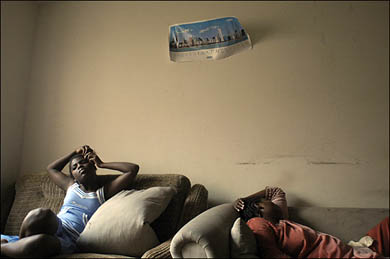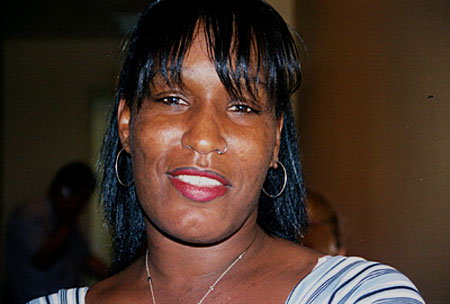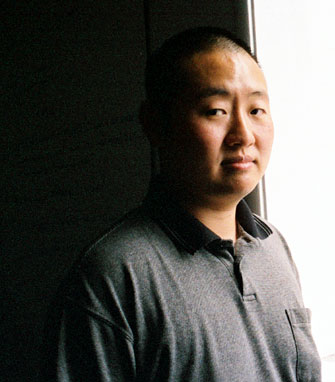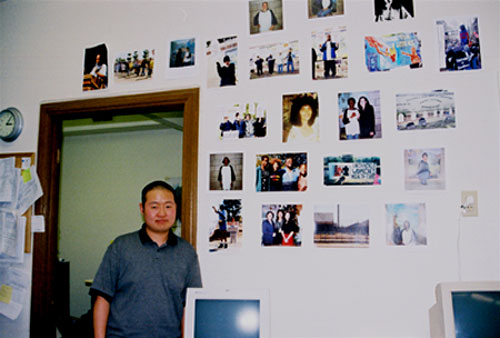Snow is falling on Tremont Street, and people are shouting. Hate is curable and preventable! Conversion therapy kills gay teens! Jesus, cleanse this temple! The steps of the Tremont Temple Baptist Church are filled with snow and people pushing up against a line of riot police and shivering in the surprise of a violent October snowstorm.
Inside, a kid in an argyle sweater and glasses sits next to his mother in the crowded pews. The muffled din of protesters bursts its way into the church every time the security guards open the doors. Tom M. (who asked that only his last initial be used) came to this conference because he loves his mom and wants to show his support for her. His mom came because she loves Tom and she’s worried about him getting into drugs, contracting AIDS, and going to hell.
Over the summer, Tom, who is 20 and a college student, finally told his mom, who is Greek Christian Orthodox and a doctor, that he’s gay. Instead of dragging him to the family priest, as Tom expected, his mom went on the Internet. She learned that Dr. Joseph Nicolosi, the president of the National Association for Research and Therapy of Homosexuality (NARTH), would be speaking on “the condition of male homosexuality” at the next “Love Won Out” meeting — a traveling conference series created by the Christian powerhouse Focus on the Family — so she bought two plane tickets from Cleveland to Boston.
They were a little late getting to the conference, and by the time they arrived, protesters had lined the steps of the church. Tom felt embarrassed and ashamed as they were escorted into the building, bag-searched, and given orange identification bracelets, but he decided to go through with it for the sake of his mom.
A few rows away from Tom sits Josh Greene (who asked that his name be changed), a young man in a tight white T-shirt and yarmulke. Unlike most people at events like “Love Won Out,” Josh, who’s 28, is Jewish Orthodox, not socially conservative — he’s in favor of gay marriage, and doesn’t believe homosexuality is necessarily bad. Most of his friends are gay, and he pretty much dates only men. He has lived in Manhattan, New York City, his whole life, surrounded by gay-affirmative culture. Josh is at the meeting because for the past three years, he has been seeing a private reparative therapist trained by Dr. Nicolosi. Even though he has same-sex attractions, he doesn’t believe he was born gay.
“Love Won Out” is here today in Boston to send the message to the state of Massachusetts — which in May 2004 became the first state to allow gay marriages — that gay people can turn straight. Tom and Josh — two gay men — sit among the people inside the church, many of whom are raising their hands into the air and praying. They pray for the queers outside, and for the depravity that has seeped into the community. They pray along with the pastor, who says: “They’re standing out there and it’s snowing. It’s bitterly cold. I can see the hurt, the anger, the hatred in their eyes.” Some people are looking a little shaky. A couple of cops have come inside to stand guard, and a woman clutches her purse while telling her friend that not even the Disney channel is safe anymore.
There’s an audible sigh of relief when Melissa Fryrear, director of gender issues for Focus on the Family’s government and public policy division, starts tapping the microphone. She says that in Kentucky, where she’s from, they do two things well: fast horses and big women. Melissa, a bubbly gal of generous proportions, came all the way to Boston to spread a little sweetness over the bitter pill a lot of folks in the audience are having trouble swallowing. It’s called being gay. But Melissa, who “used to be 99.9 percent a lesbian” but is now “seeking a tall red-headed man in his early 40s, who loves football and might look great in a Scottish kilt,” came here to spread what she calls a message of hope: Homosexuality is not immutable; there is no such thing as the perfect family; and there are lies being put forward by the enemy, not the truth.
Arguing over the definition of success
The Boston conference was a first for both Tom and Josh, but both had done their homework on the history of “Love Won Out” before attending. Developed in 1998 by Focus on the Family — an evangelical Christian nonprofit that works interdenominationally to preserve traditional family values — “Love Won Out” is touted by its organizers as a response to the “gay propaganda” being embraced by many American schools and churches. Focus was concerned by the cultural shift toward widespread acceptance of the gay lifestyle, and felt that many people were confused about what to believe. “Love Won Out” was created to answer those questions, primarily through testimonials of former homosexuals who claim to have turned heterosexual.
One such former homosexual is Alan Chambers, president of Exodus International, the world’s largest Christian ex-gay organization. Focus regularly hires Chambers and other Exodus representatives to promote the message at “Love Won Out” that change is possible. At today’s conference, Chambers’ speech on “Hope for Those Who Struggle” is aimed specifically at people who are unhappy living the gay lifestyle, and one thing Chambers really enjoys is giving hope through metaphor.
“Ever been on an airplane and gotten dehydrated?” asks Chambers. “You know you’re supposed to drink water instead of Coke, but you really want to order the Coke instead. But contrary to what they say, Coke isn’t the real thing. It may quench your thirst, but it doesn’t do what water is intended to do.”
People nod their heads and chuckle; it seems true enough. They’re here today, most of them, because they’re gay or love someone who is, and in Chambers’ estimation, that’s bad because — like Coke — homosexuality isn’t natural and good for you. The belief that homosexuality is unnatural forms the underlying basis of reparative or conversion therapy, a form of psychotherapy meant to change a person’s sexual orientation from gay to straight, and groups like Exodus draw heavily on reparative literature. (Parents, Families, and Friends of Lesbians and Gays [PFLAG], a gay-affirmative organization, notes on its website that reparative therapy has no support from major medical and mental health professional organizations.)
Chambers doesn’t sugarcoat his message by telling people it’s easy to change from gay to straight, but that’s because he doesn’t have to. Most “Love Won Out” attendees already agree that homosexuality is like Coke: It won’t necessarily kill you, but it’s not going to improve your health. Moreover, the idea of a perennial battle against cravings and desires is a familiar one to religious fundamentalists, who make up a large part of the audience at these events. So when Chambers talks about the necessary suppression of urges and tells the crowd “there is no such thing as a struggle-free life,” the crowd doesn’t wonder why indulging certain urges would be bad.
Except for Tom. Chambers has been explaining that homosexuality is “cannibalistic” and “a medication that keeps us coming back over and over again” and “like living off credit cards — it’s a counterfeit to make us feel better for a period of time.” And Tom has been rummaging around in his book bag. When Chambers opens the floor for discussion, Tom pulls out a copy of The Advocate, a national gay and lesbian publication, and raises his hand.
“Have you heard of John Evans?” asks Tom, whose mom sits beside him, looking troubled. Chambers, too, seems uneasy, but admits that he does know Evans, who, as cofounder of the ex-gay group Love in Action, later renounced that organization as misleading and harmful to gays. Quoting Evans, Tom goes on: “Since leaving the ex-gay ministry I have seen nothing but shattered lives, depression, and even suicide among those connected with the ex-gay movement.” Then he asks Chambers, “What’s your opinion of Evans, and how can you continue to preach this information when a founder saw after a few years how wrong it was to try and change the way people are?”
Not a bad question. In fact, no one really knows how well transformational ministries and reparative therapy work, which is to say that people measure success and failure differently, and in the jargon of groups like Exodus, someone who “struggles with same-sex attraction” isn’t “gay” because “homosexuality” doesn’t “exist.” To be gay in this estimation means simply to take on the political and social identity of gayness; heterosexuality is the natural and indisputable norm, regardless of homosexual feelings, because a man’s body and a woman’s body together enable humankind. No one’s denying homosexual urges exist; the question is what to do with those urges. Chambers analogizes it this way: “Your feelings lie to you all the time. If there’s a piece of chocolate in front of me, of course I want to eat it, and my feelings say yes. But eating chocolate isn’t good for me, and if I eat enough of it, it could make me die.”
Then there’s the issue of whether change is possible, and how to measure it. According to reparative therapist Jim Phelan, it’s important to recognize the difference between change and success. “Very few people change,” he says, noting that only a third of his clients reach true heterosexuality. “But many have success, which is measured differently for each person. For some men, success means being married and having sex with their wife and not thinking of a man when they do.”
But Chambers doesn’t mention the issue in his response to Tom. “Well,” says Chambers, “we can live how we choose. I see very little despair in ex-gays. What John Evans says has not been my experience. Next question?”
Josh raises his hand and asks for more specifics in terms of the methods and techniques Exodus uses to help strugglers.
“We’ve got over 130 member ministries, and all of them are different,” Chambers explains. “We don’t endorse shock therapy or aversion therapy. Our most important thing is not that people change their sexual orientation, but that they change their relationship with Jesus Christ.” Adjusting his yarmulke, Josh looks somewhat puzzled, but Chambers quickly moves on to another question, this time from a woman who wants to know about expectations for those who are struggling with homosexuality.
“You can expect a life of struggle with sin, but you can also expect joy incomparable,” advises Chambers, adding that even his worst day in heterosexual life is still better than his best day in the gay community.
The symbolism of suffrage, of an existence driven by struggle against temptation, isn’t lost on religious members of the audience, but to others, such language seems hypocritical. “I have a problem with the term ‘struggle,’” says Wayne Besen, a gay rights activist and author of Anything But Straight: Unmasking the Scandals and Lies Behind the Ex-Gay Myth. “That’s a false term when it comes to the ex-gay ministries, because a struggle suggests that you have a chance to win. If you don’t, it’s not a struggle. It’s a slaughter.” Besen, who spent years documenting the ex-gay movement by interviewing ministry leaders and attending ex-gay groups undercover, claims that for most people who get involved in reparative therapy, trying to change their sexual orientation is fruitless. “In six months, these people are going to be just as gay as the day they walked in the door,” he says. “What struggle? I have never seen a struggle, I’ve just seen misery.”
But Chambers is focused on hope. He turns the question on the audience, asking what they hope for. The answers spill forth: Freedom for my children. The joy you talked about. The right answers. The compassion to understand. That God will take over the heart of anyone who just wants to get homosexuality out. To feel about girls the way I feel about guys.
This isn’t just about God, or Biblical interpretation, or converting people to Christianity, or impressionable youth, or the culture wars, or the political agenda of the religious right, though all are reasons why the ex-gay movement has recently experienced a drastic increase in size and scope. It’s about people knee-deep in emotional pain. But the key players in the ex-gay movement have their eye on a much bigger bounty: the establishment of a Christian nation.
- Follow us on Twitter: @inthefray
- Comment on stories or like us on Facebook
- Subscribe to our free email newsletter
- Send us your writing, photography, or artwork
- Republish our Creative Commons-licensed content













